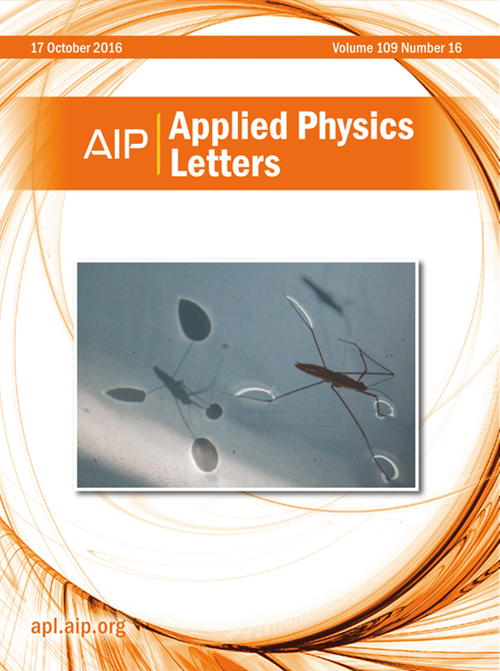二维反铁磁CuFe2X4 (X=S, Se)的可切换极化
IF 3.5
2区 物理与天体物理
Q2 PHYSICS, APPLIED
引用次数: 0
摘要
二维AgCr2S4的合成引起了人们对AM2X4型非范德华材料的极大兴趣。AM2X4单分子层通过插层破坏了体系的中心反演对称性,产生了本禀多铁性。基于近年来FeS2单层的实验成果,我们预测了两种本构多铁性材料:CuFe2S4和CuFe2Se4。利用第一性原理计算,我们证明了它们的铁电性和铁磁性。我们的研究结果表明,应变可以通过离子中心和电子密度中心的不同位移来改变极化方向。在环境条件下,CuFe2X4 (X = S, Se)单分子层具有垂直方向的反铁磁耦合。CuFe2S4和CuFe2Se4单层膜的自发极化分别为1.73和1.42 pC/m。施加超过3%的压缩应变可使CuFe2S4的极化方向逆转,而施加4%的拉伸应变可使CuFe2S4的极化达到2.65 pC/m。此外,应变有效地影响了磁基态、易轴方向和不同轨道杂化的贡献。这些发现有助于我们理解CuFe2X4单层的铁磁性和铁电机制,并扩展了二维多铁性材料的家族。本文章由计算机程序翻译,如有差异,请以英文原文为准。
Switchable polarization in 2D antiferromagnetic CuFe2X4 (X=S, Se)
The synthesis of two-dimensional AgCr2S4 has generated significant interest in AM2X4 type non-van der Waals materials. AM2X4 monolayer breaks the central inversion symmetry of the system by intercalation, resulting in intrinsic multiferroicity. Based on recent experimental achievements of the FeS2 monolayer, we predict two intrinsic multiferroic materials: CuFe2S4 and CuFe2Se4. Utilizing first-principles calculations, we demonstrate their ferroelectric and ferromagnetic properties. Our findings indicate that strain can switch the direction of polarization due to the different displacements of the ionic center and the center of electron density. CuFe2X4 (X = S, Se) monolayers are metal with antiferromagnetic coupling in the perpendicular direction under ambient conditions. The spontaneous polarizations for CuFe2S4 and CuFe2Se4 monolayers are 1.73 and 1.42 pC/m, respectively. Applying a compressive strain exceeding 3% can reverse the polarization direction, while a tensile strain of 4% enhances the polarization of CuFe2S4 to 2.65 pC/m. In addition, the strain effectively influences the magnetic ground state, the direction of the easy axis, and the contribution of different orbital hybridization. These findings help us understand the ferromagnetic and ferroelectric mechanisms in the CuFe2X4 monolayers and expand the family of 2D multiferroic materials.
求助全文
通过发布文献求助,成功后即可免费获取论文全文。
去求助
来源期刊

Applied Physics Letters
物理-物理:应用
CiteScore
6.40
自引率
10.00%
发文量
1821
审稿时长
1.6 months
期刊介绍:
Applied Physics Letters (APL) features concise, up-to-date reports on significant new findings in applied physics. Emphasizing rapid dissemination of key data and new physical insights, APL offers prompt publication of new experimental and theoretical papers reporting applications of physics phenomena to all branches of science, engineering, and modern technology.
In addition to regular articles, the journal also publishes invited Fast Track, Perspectives, and in-depth Editorials which report on cutting-edge areas in applied physics.
APL Perspectives are forward-looking invited letters which highlight recent developments or discoveries. Emphasis is placed on very recent developments, potentially disruptive technologies, open questions and possible solutions. They also include a mini-roadmap detailing where the community should direct efforts in order for the phenomena to be viable for application and the challenges associated with meeting that performance threshold. Perspectives are characterized by personal viewpoints and opinions of recognized experts in the field.
Fast Track articles are invited original research articles that report results that are particularly novel and important or provide a significant advancement in an emerging field. Because of the urgency and scientific importance of the work, the peer review process is accelerated. If, during the review process, it becomes apparent that the paper does not meet the Fast Track criterion, it is returned to a normal track.
 求助内容:
求助内容: 应助结果提醒方式:
应助结果提醒方式:


